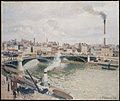
Oscar-Claude Monet was a French painter and founder of impressionism painting who is seen as a key precursor to modernism, especially in his attempts to paint nature as he perceived it. During his long career, he was the most consistent and prolific practitioner of impressionism's philosophy of expressing one's perceptions of nature, especially as applied to plein air (outdoor) landscape painting. The term "impressionism" is derived from the title of his painting Impression, soleil levant, which was first exhibited in the so-called "exhibition of rejects" of 1874–an exhibition initiated by Monet and like-minded artists as an alternative to the Salon.
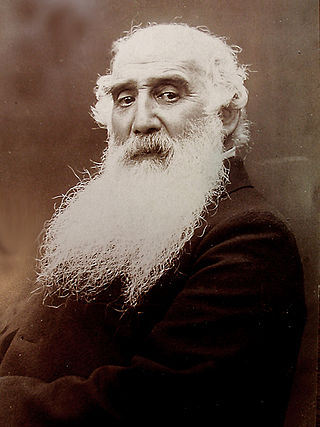
Jacob Abraham Camille Pissarro was a Danish-French Impressionist and Neo-Impressionist painter born on the island of St Thomas. His importance resides in his contributions to both Impressionism and Post-Impressionism. Pissarro studied from great forerunners, including Gustave Courbet and Jean-Baptiste-Camille Corot. He later studied and worked alongside Georges Seurat and Paul Signac when he took on the Neo-Impressionist style at the age of 54.
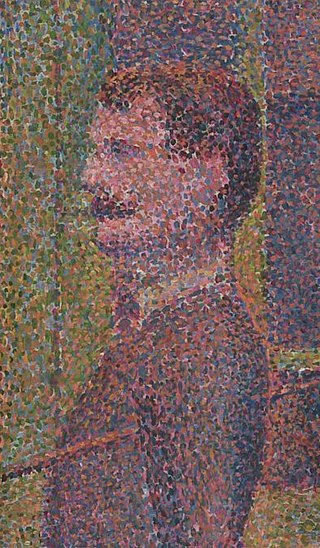
Pointillism is a technique of painting in which small, distinct dots of color are applied in patterns to form an image.

Alfred Sisley was an Impressionist landscape painter who was born and spent most of his life in France, but retained British citizenship. He was the most consistent of the Impressionists in his dedication to painting landscape en plein air. He deviated into figure painting only rarely and, unlike Renoir and Pissarro, he found that Impressionism fulfilled his artistic needs.
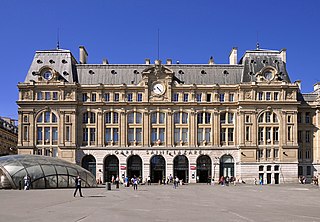
The Gare Saint-Lazare, officially Paris Saint Lazare, is one of the seven large mainline railway station terminals in Paris, France. It was the first train station built in Paris, opening in 1837. It mostly serves train services to western suburbs, as well as intercity services toward Normandy using the Paris–Le Havre railway. Saint-Lazare is the third busiest station in France, after the Gare du Nord and Gare de Lyon. It handles 290,000 passengers each day. The current station building opened in 1889 and was designed by architect Juste Lisch; the maître d'œuvre was Eugène Flachat.

Maximilien Luce was a prolific French Neo-impressionist artist, known for his paintings, graphic art, and his anarchist activism. Starting as a wood-engraver, he then concentrated on painting, first as an Impressionist, then as a Pointillist, and finally returning to Impressionism.
The year 1896 in art involved some significant events.

Charles Angrand was a French artist who gained renown for his Neo-Impressionist paintings and drawings. He was an important member of the Parisian avant-garde art scene in the late 1880s and early 1890s.

The Rouen Cathedral series was painted in the 1890s by French impressionist Claude Monet. The paintings in the series each capture the façade of Rouen Cathedral at different times of the day and year and reflect changes in its appearance under different lighting conditions.
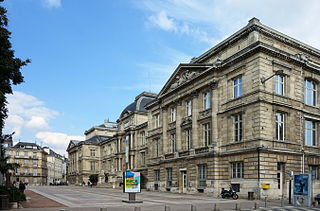
The Musée des Beaux-Arts de Rouen is an art museum in Rouen, in Normandy in north-western France. It was established by Napoléon Bonaparte in 1801, and is housed in a building designed by Louis Sauvageot and built between 1877, and 1888. Its collections include paintings, sculptures, drawings and objets d'art.

Blanche Hoschedé Monet was a French painter who was both the stepdaughter and the daughter-in-law of Claude Monet.

Seine (paintings) is the subject and location of paintings that Vincent van Gogh made in 1887. The Seine has been an integral part of Parisian life for centuries for commerce, travel and entertainment. Here van Gogh primarily captures the respite and relief from city life found in nature.

Robert Antoine Pinchon was a French Post-Impressionist landscape painter of the Rouen School who was born and spent most of his life in France. He was consistent throughout his career in his dedication to painting landscapes en plein air. From the age of nineteen he worked in a Fauve style but never deviated into Cubism, and, unlike others, never found that Post-Impressionism did not fulfill his artistic needs. Claude Monet referred to him as "a surprising touch in the service of a surprising eye".

Le Pont aux Anglais, soleil couchant is an oil painting created in 1905 by the French artist Robert Antoine Pinchon (1886–1943). Associated with the new generation of l'École de Rouen Pinchon executed this work in a Post-Impressionist style with a subdued Fauve or Neo-Impressionist palette of golden yellows and incandescent blues. The dynamic image of the train in Pinchon's painting is an homage to the emerging industrialized world.

Albert Lebourg, birth name Albert-Marie Lebourg, also called Albert-Charles Lebourg and Charles Albert Lebourg, was a French Impressionist and Post-Impressionist landscape painter of the Rouen School. Member of the Société des Artistes Français, he actively worked in a luminous Impressionist style, creating more than 2,000 landscapes during his lifetime. The artist was represented by Galerie Mancini in Paris in 1896, in 1899 and 1910 by : Galerie Bernheim-Jeune, 1903 and 1906 at the Galerie Paul Rosenberg, and 1918 and 1923 at Galerie Georges Petit.

Morning, An Overcast Day, Rouen is a late 19th-century painting by Danish-French artist Camille Pissarro. Done in oil on canvas, the work depicts the industrial cityscape of Rouen, France. The centerpiece of the painting is Boieldieu Bridge, a steel arch bridge which Pissarro painted from his room in a nearby hotel. The painting is in the collection of the Metropolitan Museum of Art.
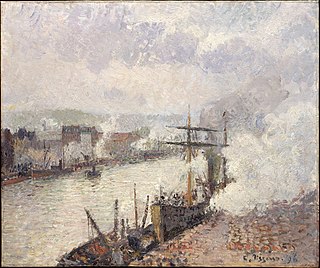
Steamboats in the Port of Rouen is a late 19th-century painting by Camille Pissarro. Done in oil on canvas, the painting depicts shipping in the port city of Rouen, France. Pissarro painted the work from his room in the Hôtel de Paris, which overlooked the one of the city's quays. The painting is similar to Pissarro's Morning, An Overcast Day, Rouen, and both works are in the collection of the Metropolitan Museum of Art.
Antonin Personnaz was a French art collector and early colour photographer.
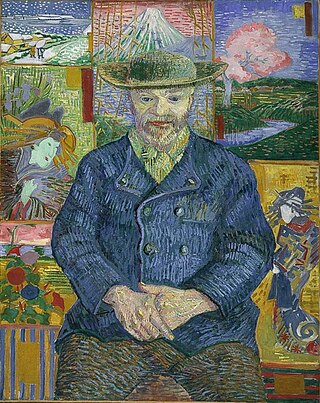
Julien François Tanguy, called Père Tanguy was a French art dealer, gallery owner, art collector, and patron who was one of the first buyers of Impressionist paintings. He played an important role in promoting Impressionism and Post-Impressionism.



